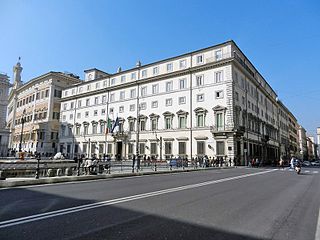Related Research Articles

The Bank of Italy, known in Italian as [La] Banca d'Italia, is the central bank of Italy and part of the European System of Central Banks. It is located in Palazzo Koch, via Nazionale, Rome. The bank's current governor is Ignazio Visco, who took the office on 1 November 2011.

The Ministry of Internal Affairs and Communications is a cabinet-level ministry in the Government of Japan. Its English name was Ministry of Public Management, Home Affairs, Posts and Telecommunications (MPHPT) prior to 2004. It is housed in the 2nd Building of the Central Common Government Office at 2-1-2 Kasumigaseki in Chiyoda, Tokyo, Japan.

Poste Italiane S.p.A. is the Italian postal service provider. Besides providing postal services, Gruppo Poste Italiane offers integrated communication, postal savings products, logistics, financial and insurance services throughout Italy.

The Reichspostministerium (RPM) in Berlin was the Ministry in charge of the Mail and the Telecommunications of the German Weimar Republic from 1919 until 1933 as well as of Nazi Germany from 1933 to 1945.

The Ministry of Transportation and Communications is a cabinet-level governmental body of the Republic of China (Taiwan) in charge of all policy and regulation of transportation and communications networks and administration of all transportation and communications operations and enterprises in Taiwan.

The Ministry of Transport, Mobility and Urban Agenda (MITMA), traditionally known as the Ministry of Development (MFOM), is the department of the Government of Spain responsible for preparing and implementing the government policy on land, air and maritime transport infrastructure and the control, planning and regulation of the transport services on this areas. It is also responsible for guaranteeing access to housing; urban, soil and architecture policies; planning and controlling the postal and telegraph services, directing the services related to astronomy, geodesy, geophysics and mapping, and planning and programing the government investments on infrastructure and services related to this scope. The Ministry's headquarters are in the New Ministries government complex.

The Ministry of Infrastructure and Transport is the government ministry for transport in the Republic of Italy. It is responsible for all transport infrastructure as well as general transport planning and logistics, especially for urban transport schemes. It is led by the Italian Minister of Transport.

The Ministry of Economic Development is a government ministry of the Italian Republic. It deals with production, economic activities, energy and mineral resources, telecommunications, consumers, tourism, internationalisation and business incentives. It was formed in 2006 after the reorganization of the Ministry of Productive Activities to which were merged the Ministry of Communications and the Ministry of International Trade in 2008.

The Ministry of Economic Affairs and Digital Transformation (MINECO) is the department of the Government of Spain responsible for the proposing and carrying out the government policy on economic affairs, business support and reforms to improve economic potential growth as well as acting as the communication channel with the European Union and other economic and financial international organizations in this matters. Likewise, this department is responsible for the telecommunications policy and the digital transformation.

Egypt Post is the governmental agency responsible for postal service in Egypt. Established in 1865, it is one of the oldest governmental institutions in the country.
The Communications Authority of Kenya (CA) is the regulatory Authority for the ICT industry in Kenya with responsibilities in telecommunications, e-commerce, broadcasting and postal/courier services. The CA is also responsible for managing the country’s numbering and frequency spectrum resources, administering the Universal Service Fund (USF) as well as safeguarding the interests of users of ICT services.

The Information and Communication Technologies Authority (ICTA), is a national telecommunications regulatory and inspection authority of Turkey. It was formerly known as the Telecommunications Authority.
The Ministry of Maritime Affairs, Transport and Infrastructure of the Republic of Croatia is a ministry in the Government of Croatia.

The Ministry of Economy and Finance, is a ministry of the Italian government. Its responsibilities include overseeing economic policy, public investments and spending. The Ministry's headquarters are located in the historic Palazzo delle Finanze. The current minister is Daniele Franco of Draghi Cabinet.
The Polizia Postale e delle Comunicazioni is one of the units of the Polizia di Stato, the State Police of Italy. Its functions include the investigation of cybercrime.

The Ministry of Communications was a Cabinet-level ministry in the Empire of Japan. Its modern successors include the Ministry of Internal Affairs and Communications, Japan Post and Nippon Telegraph and Telephone

The Presidency of the Council of Ministers is the administrative structure which supports the Prime Minister of Italy. It is thus the Italian equivalent of the Prime Minister's Office. It contains those departments which carry out duties invested in the office of the Prime Minister. Duties invested in the Italian executive government generally are not administered by the Presidency, but by the individual ministries.
The Secretary of State for Telecommunications and Digital Infrastructures (SETID) is senior minister of the Spanish Department of Economic Affairs and Digital Transformation.

A Ministry of the Republic of Italy is an administrative organ of the Republic of Italy, placed at the top of Italian public administration and is characterised by one or more specific competencies, with an organised structure, often varying over time.